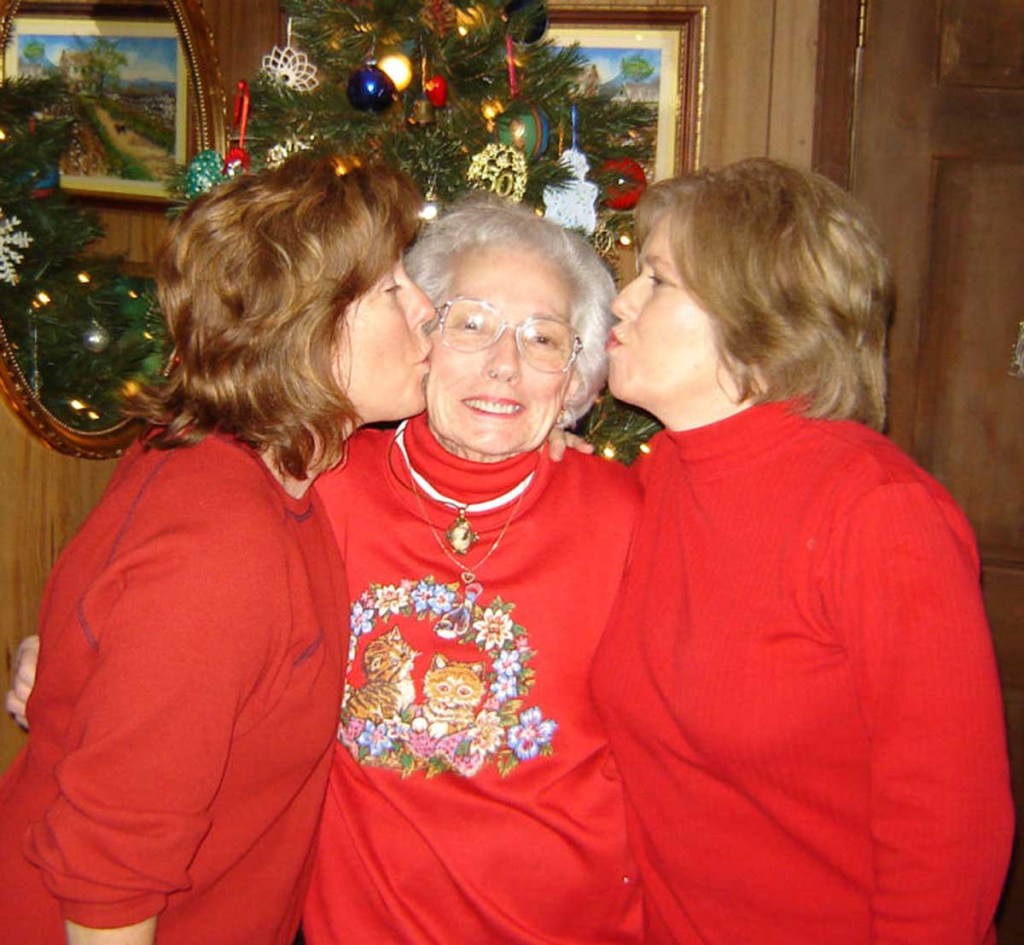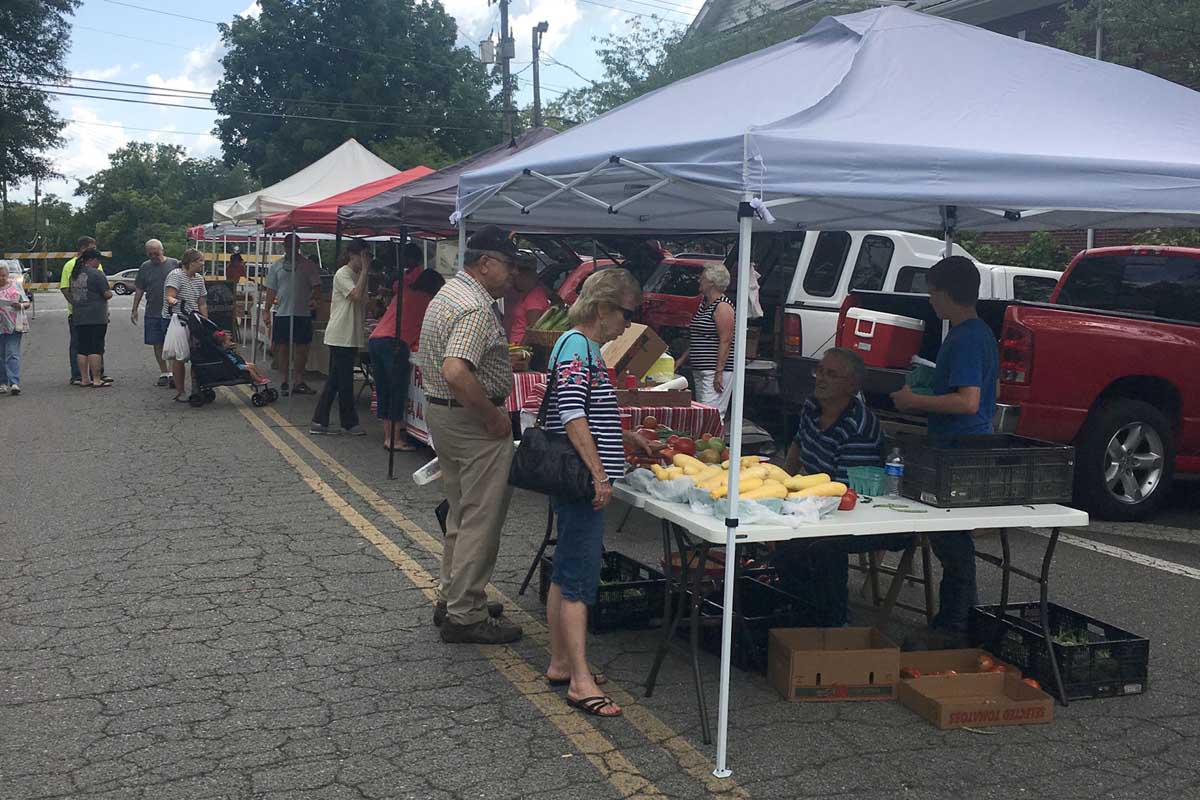The Holladay Sound
Published 2:50 pm Tuesday, July 6, 2010

- The Holladays during the holidays: Ginger and Mary show their love and affection for their mother, Hilda
August 17, 1977
Trending
The recording session came to an abrupt halt when they heard the news. As they were preparing to lay down backing vocals, the session came to an abrupt halt for a reason no one in the recording room could see.
Then, someone in the mixing booth announced to the room that Elvis Presley had died. The Holladay Sisters said a studio engineer voiced what everyone in the room was feeling at the time, “You know, none of us would be here if it wasn’t for him.”
Their road to success was paved by their voices, but it was Elvis who gave them their second big opportunity: to record backing vocals on the No. 1 hit, “In the Ghetto.”
Opening stanzas
Mary Holladay Pederson was born and raised in Pell City. It was there that she sang in the junior choir at the local Baptist Church and learned to play ukulele from her father, J.T. Holladay. In the seventh grade, Mary and three of her friends started harmonizing together, mimicking the Lennon Sisters on the Lawrence Welk show.
Mary and her friends Susan Coleman Pilkington, Donna Adams Hooks and Pattie Wright Sims would be featured at high school talent shows, dances and even got to sing on the Country Boy Eddie Show in Birmingham. The group would sing as they strummed baritone ukuleles or belt out a capella renditions of hits from the 1950s and 1960s.
“We had a great time,” Mary, who sings soprano, recalled.
Her younger sister, Ginger Holladay, would eventually follow in Mary’s footsteps.
“Our mother and father were a big influence,” Ginger said. “Mother would always make sure we had piano, vocal lessons and dance lessons. She practically sold her furniture to make sure we did.”
Ginger also sang in the junior choir at the First Baptist church and later played in a high school folk group. “I guess I always wanted to be like my big sis, really,” she said.
Mary would go on to Auburn and study music education. In her junior year her friend Susan Coleman was singing with a group that was going to be working with an artist in Muscle Shoals, the birthplace of many hits of the late 1960s and 1970s.
“She asked me to come and sing backup,” Mary said. “We didn’t even know what backup really was; we just knew we could harmonize.”
The group The Box Tops recorded “The Letter” and then “Cry Like a Baby,” which Mary and Susan sang on. That song gave Mary her first glimpse of the music business.
“When the song would come on the radio at Auburn, the two of us would dance up and down the halls with the music playing in the background and us singing the ‘cry like a baby’ part,” Mary said.
In Muscle Shoals, they met Jeanie and Marlin Greene. Marlin had just produced a hit for an upstart artist named Percy Sledge. The song was “When a Man Loves a Woman.” In the years that followed, Jeanie Greene would become Mary and Ginger’s mentor as they worked tirelessly in recording studios producing the backing vocals on many of the hits of the 1960s and 1970s.
After their first session, Mary, Susan Pilkington and Donna Thatcher were asked by Marlin and Jeanie Greene to come back and record again. From that point on, Mary would drive from Auburn to Muscle Shoals most weekends to lay down backing vocal tracks.
After moving from Auburn to Muscle Shoals, Mary began living the life of a struggling artist: barely making rent by asking American Studios for advances on paychecks and plugging her electric cord into a neighbor’s house to keep the lights on. At that time, Mary was working with Percy Sledge, Joe Tex, Joe Simon and many other artists who worked in Muscle Shoals Sounds, Quinn Ivy Music and Fame studios.
In January 1969, Mary asked her 17-year-old little sister Ginger—who was a senior at Pell City High School and later attended college at Memphis University—to come live with her. From that point on, the ends began to meet as their lives took a turn for the best.
The Holladay sessions
Ginger’s big sister had been laying down backing vocals along with Jeanie Greene and Susan Coleman on an Elvis track when Susan got laryngitis. The younger Holladay sister’s first song with Elvis was “In the Ghetto,” which went to No. 1. They sang backing vocals on “Suspicious Minds” and “Kentucky Rain” as well.
Ginger recalls what it was like to know The King of Rock ‘n’ Roll over the years they worked together. “He was just larger than life. No kidding,” she said. “ When he would walk into the recording room you knew he was there, even if you had your back turned and headphones on. That’s the kind of energy and presence he had.”
The sisters started recording in Memphis and Muscle Shoals. “We would decide what to do in the control room, mostly,” Mary said. “We would work out the parts ourselves with the producer or the artist, if the artist was even there by the time we’d record our parts. Then we would lay down the tracks and they’d tell us if it was working or not. Then they’d cut it. You’d work on it all right there in the studio.”
At that time in the music industry, an artist’s management was not in the studio. That gave the producer, the artist and even the backing vocalists a chance to work together and get the right sound for each song.
“You’d have to not only work hard to get it right, but then you’d have to remember what worked for the next time you recorded it,” Mary recalls with a laugh.
“It was very loose at that time,” Ginger recalled of the laid-back Muscle Shoals recording atmosphere. By the time the two began working in Nashville, though, the pace was quick and often they would have to work from 10 a.m. to 2 a.m. recording with four different artists in four different studios in one day.
“We couldn’t imagine that in the Muscle Shoals sessions,” Mary said. “We could take all day to work on one song in Muscle Shoals.”
Many times throughout their career, the sisters and their fellow backup singers would also work with Nell Riser, another Pell City native. Riser accompanied them in Muscle Shoals and even on tour in the 1970s.
The sisters will admit that like most recording studio veterans, they worked on more songs that never made it to a record than those that appeared in stores or made it onto the charts.
“We were just working. It was a job, but one we really enjoyed,” Ginger said. “We got to work with all of these great artists because, I suppose, they liked our sound.”
The “Holladay Sound” as artists and producers called it, was sought after for nearly two decades. The sisters were associated with having a more soulful harmony than many of their peers. “That’s why we got to work with so many artists,” Mary said.
“When Mary and I would sing, we could blend better together and just fall right into it,” Ginger said. “So it created a sound that was kind of different. Somebody identified it as ‘blood harmony’ because it naturally blended. It was a natural thing that happened and then Jeanie was such a natural talent and she worked with us, too.”
To keep in top vocal shape, the sisters would take vocal lessons throughout the years, and even today they’ve still got the unique Holladay Sound down. They often break into spontaneous harmonies while recalling the songs they sang throughout the years.
The Holladay Sisters have worked with numerous artists during the years and sang on more hits than can be listed in this article. A few of the artists they worked with include: Joe Simon, The Box Tops, Percy Sledge, Neil Diamond, Joan Baez, Billy Swann, Ronnie Millsap, Ray Stevens, Joe Tex, Willie Nelson, Charlie Daniels, Linda Ronstadt, Sonny and Cher, Jerry Lee Lewis, Charlie Reed, Kris Kristofferson. B.B. King and Jimmy Buffet. Their backup vocals are heard on anything from “Suspicious Minds” to “Brother Love’s Travelling Salvation Show,” “The Streak,” or “Cheese Burger in Paradise.”
In the 1970s, just as Linda Ronstadt broke big into the mainstream music scene, the sisters were invited to go on tour as her back up singers. They also toured with Roger Miller, Ray Stevens and Ronnie Milsap.
In the 1980s, the two paired up to record television commercials and though the pay was better than recording studio work, Ginger said it didn’t have the same creative fulfillment as putting down extended melodies or echoing a major star on a hit single.
“The money in commercial television was really, really good,” Ginger said, “but it just wasn’t as satisfying as studio work. By the time you’d get a little jingle track down, you were done. That’s it.”
Their television work included commercials for McDonalds, Nestle Crunch and United Airlines. During the years that the sisters recorded together, Mary met her husband Steve Pederson, an Air Force Pilot. The couple would raise three girls, Molly, Meghan and Amy. The Pedersons returned to Pell City seven years ago. Mary is now the worship leader of Grace Chapel of Eden.
In 1996, Ginger married Dean Marson and the couple now reside on the west coast in Washington. Ginger has recently gone back to her roots, singing folk music at small venues around the Evergreen State and said she believes she has come full circle in that regard.
Ray Stevens produced the Holladay Sisters—along with Nell Riser, who was also a Pell City native—in a group called Mint Julip. Nell sang with the Holladay’s for about a year. The Holladay sisters say that for all the songs they sang as backup vocalists, they were never quite able to secure big-time fame, despite a demo LP they recorded with Nell and Jeanie in the 1970s.
Jokingly, they kid, “Had our brother Roy been our manager we might have made it big and been propelled to superstardom. “He’s got that kind of personality,” Ginger said beaming. “If he could’ve been our manager, we would’ve had at least three No. 1 hits.”
The sisters said one of their biggest thrills is being able to spend time and sing harmonies with their mother, Hilda, who lives in Pell City.


